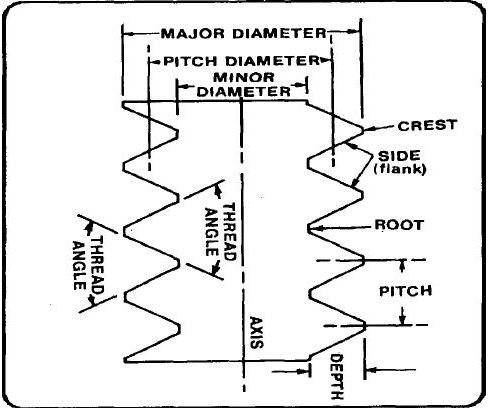Understanding Thread Names - How to Read Thread Designations for National Unified Threads (UNC, UNF, UNEF, UN)
Introduction
As was already covered in the first part of the thread standard series, there are numerous thread standards used in different countries. ISO threads (designated according to DIN standard) are used in Europe and have metric dimensions, as also those of UK (BSP standards). The UNC-UNF threads are dimensioned in inches and are used in American-developed systems. There are also more exotic threads – like UNJF and NPT (used in pipe systems). Every thread is designated according to certain rules – and in this article we will provide an overview of these rules.
American Standard Thread Designations
Major American standards use the following code: DD-PP-SS-XA/B-(LH)
DD is the major diameter of the thread. Thus 3/8-inch thread will have a 3/8 standing at the left most of the thread specification. The dimensions usually come at margins of an inch (1/2, ¼, 1/8 ,1/16 etc). It must be noted that threads with a diameter smaller than ¼ have been given special numbers, from 0 to 10.
PP stands for number of threads per inch. Thus, -20 means that there are 20 threads in each inch along the thread.
SS is the thread standard. Mostly, it is defined by the diameter and number of coils, but sometimes there are several standards (such as UNC and UNJC) that use the same numbers. Thus, this should not be omitted – also helping to prevent errors. If you will write ¼-30 –UNF beside your thread, anyone looking at this will note that something is wrong, as Unified National Fine standards defines 28 threads per inch.
X is the level of closing between the male and female thread, called class. 1 is the most loose thread, meaning there is less contact between threads and more clearance. 2 is the most common class and 3 is the most precise fit, used in accurate applications.
A or B is used to specify whether it is an external or internal thread. External thread is designated A and internal – B.
LH is used to specify the unusual left hand – used sometimes for locking against rotational force or other special applications.
Typical designations examples
So, after reading the above paragraph, you should know that:
2-56 UNF 2A means it is a #2 thread (sometimes called also 0.086, as this is 0.086 inch) with 56 threads per inch, manufactured, dimensioned and checked according to Unified National Fine Standard and this is a normal external thread.
¼ -20 – UNC -3B –LH means this is a ¼ inch diameter thread with 20 thread per inch, manufactured in accordance with Unified National Coarse Standard. The thread is internal and precise and also left handed.
7/8 – 20 – UNEF -2B stands for internal normal precision thread with a diameter of 7/8 inch and 20 threads per inch, which is Unified National Extra Fine Standard.
